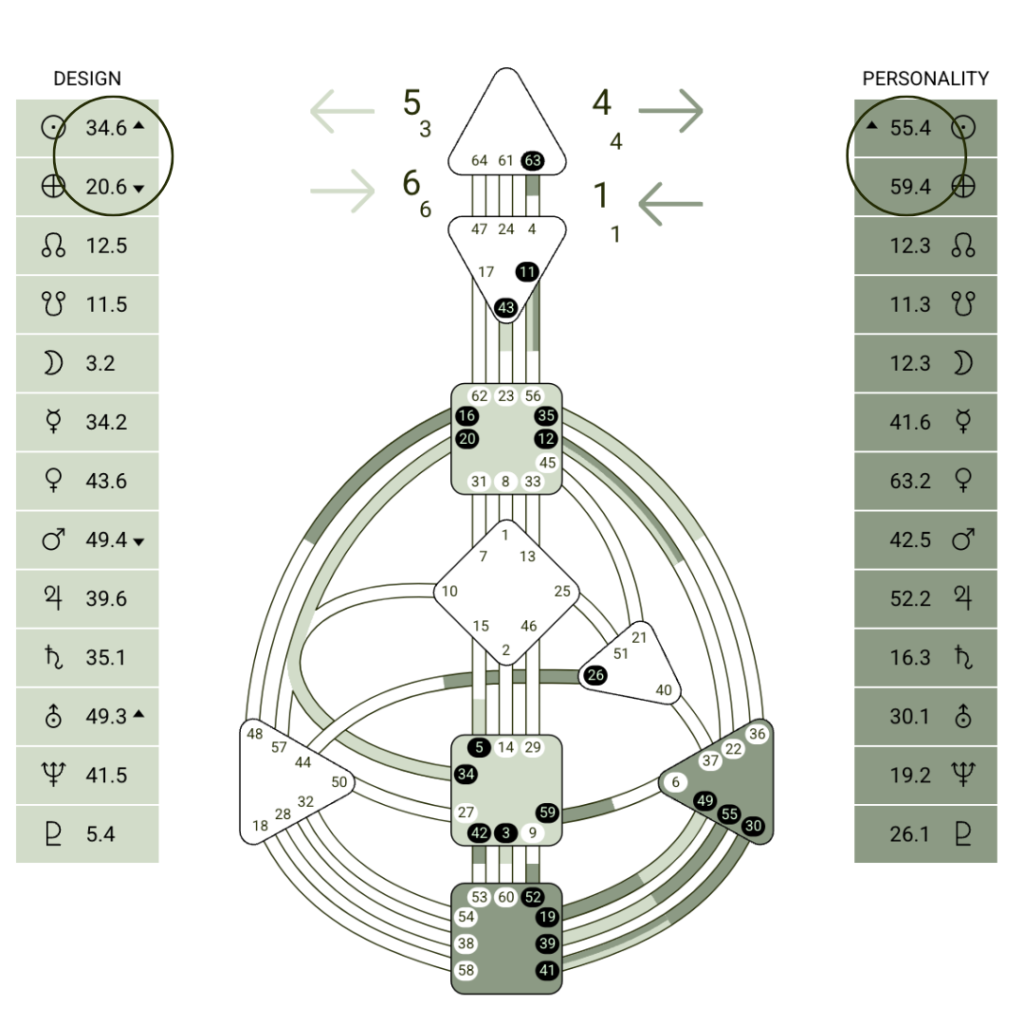Let's say you arrived at HD&Me with an interest in human design.
Chances are you’ve already done some poking around – whether on Tiktok, YouTube, Instagram, Reddit, or wherever else – and you’ve likely seen people introducing themselves in an odd way, for example as a “1/3 projector” or a “6/2 generator.”
“Projectors” and “generators” are two of the five energy types of human design – that’s pretty straightforward, even if you don’t know all the ins-and-outs. (You can read up on the five energy types here in our post entitled “Your Life in HD: Energy Type.”)
…but what are the numbers? What do they mean?
Well, in a human design context, whenever you see two numbers (1 through 6) separated by a slash, you’re not looking at a fraction; you’re looking at someone’s profile.
Profiles reveal a consistent feature of all human design charts.
Look at any person’s chart, and you’ll notice that the first two numbers AFTER the decimal point in both columns in the chart are identical. So in the example chart below, you’ll see 34.6 and 20.6 as the first two numbers in the column on the left and 55.4 and 59.4 as the first two numbers in the column on the right. The person with this chart would have a “4/6 Profile.”

So... why these numbers?
As we explained in “Gates and Lines,” the numbers AFTER the decimal points refer to the six lines of human design, which you can understand as the six patterns of being, the ways in which we live out themes of the human experience throughout our lives.
“Profile” is the closest thing in human design to the Myers-Brigg or Enneagram “types,” except that your profile isn’t just your personality type. Your profile combines the most fundamental patterns of your personality and unconscious self into a two-number set, which together can be understood as the leading patterns in your life. The first number is the leading pattern of your personality, and the second number is the leading pattern of your unconscious self.
Back in the section on “Gates and Lines,” we explained that each of the six lines of human design reflect a different but interconnected “prime motivation” in life: security, autonomy, novelty, connection, impact, and transcendence. The two leading patterns in your profile are driven by two prime motivations.
Here’s a simple overview of what those prime motivations mean, at a fundamental level, to the people who have them in their profiles:
To use our examples above, when someone has a 1/3 profile, it means that their personality is driven by the prime motivation of security (1), and their unconscious self is driven by novelty (3). When someone has a 6/2 profile, their personality is driven by the prime motivation of transcendence (6), and their unconscious self is driven by autonomy (2). These are their leading patterns in life, which can trickle down into many different aspects of their thought, expression, emotions, and behavior.
The first three lines (1-3) are the “personal” patterns, those which center on the individual’s needs and benefits. The second three lines (4-6) are “transpersonal” patterns, the ones which transcend individual concerns and project outward onto others and the world at large. Having a personal or transpersonal line in your profile doesn’t bind you to “selfishness” or “selflessness,” as those words are commonly understood, but rather orient you toward a particular posture in your day-to-day interactions with the universe. As with so many other aspects of the human design system, there are no automatic moral or ethical foundations, only mechanics and the potential of expression.
The founder of human design, Ra Uru Hu, described our profiles as “the costume of our purpose,” basically how we’re designed to ride through life on the road to destiny.
That’s one way to look at it. Yet despite their widespread use (and overuse, in our opinion), profiles aren’t NEARLY as important as most human design resources would have you believe.
Think of profiles as a set of binoculars: They can help you make better sense of something, but only at a certain distance. Binoculars are useless for seeing the nitty-gritty up close, or for seeing things that are very far away. You’d use a magnifying lens or a microscope to look at small things close by, to make sense of the parts too small to see with the naked eye, and you’d use a telescope to visualize things at a vast distance in greater detail. Human design is full of magnifying glasses and microscopes and telescopes, which is a good thing because there is a lot to see.
At HD&Me, we prefer to treat profile for what it really is, as a form of shorthand. Everyone has two dominant aspects of their unconscious and their personality, two patterns that influence their life above all others, but not at the expense of all others. Profile is illuminating and fun, but it’s limited. There’s an entire world out there – above and underneath the surface. We’re here to guide you through it all.
Speaking of guiding you, let’s move on to the next post in our introductory series, entitled “Your Life in HD: Channels and Centers.”
